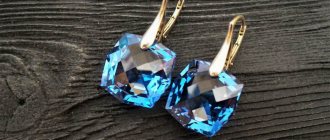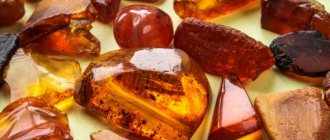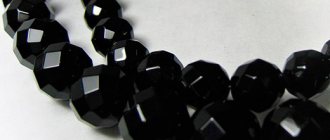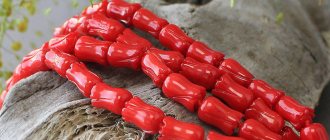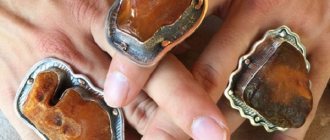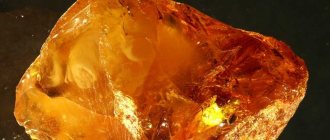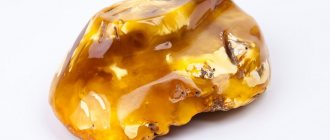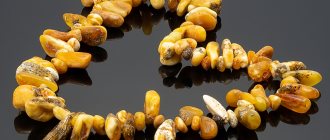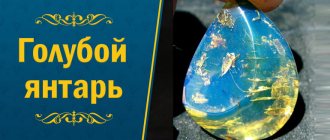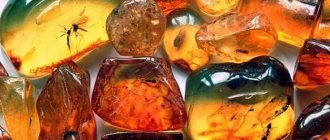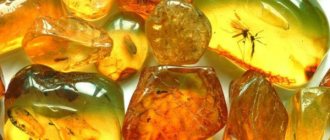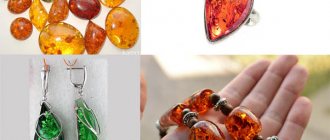Perhaps, few people know that amber is an amazing stone, because it can be painted in a variety of shades, the number of which exceeds 250 varieties. The most common is yellow amber, honey, almost orange. However, there are types of it that amaze with their depth of color and richness of color. These include red amber, with a ruby-red hue.
Scarlet royal stone amber
The rarity of the red variety of amber made it an attribute of the elite. Since the times of Ancient Egypt, jewelry with scarlet amber fragments or inserts was allowed to be worn only by rulers and representatives of the upper classes.
The crown of the Egyptian pharaoh Tutankhamun and the robes of Eastern monarchs are decorated with such ambers.
| Formula | C10H16O+(H2S) |
| Color | Light yellow, brown, red, milky white, greenish |
| Shine | Smolyanoy |
| Transparency | Variable: from almost transparent to completely opaque |
| Hardness | 2-2,5 |
| Cleavage | Absent |
| Kink | Conchoidal; viscous (becomes brittle with aging) |
| Density | Typically 1.05-1.09, maximum 1.3 g/cm³ |
bobot 02/25/201902/25/2019 Category NatureTags amber Comment.
The weight of amber pieces varies - from fractions of a gram to several kilograms. Large pieces of amber are found only in the Baltic states and Ukraine. The largest pieces of amber were found in the second half of the 19th century: one, weighing 12 kg, in Prussia (it was valued at 25 thousand francs), another, weighing 9.7 kg, in Pomerania.
At the end of the last century, a piece of amber weighing about 7 kg was found on the shores of the Baltic Sea. A piece of amber weighing 6750 g, 37 cm long, 21 cm wide and 14 cm thick was exhibited in the Museum of the University of Konigsberg. It was valued at 30 thousand marks.
A unique find of amber weighing 4280 g is kept in the museum at the Kaliningrad Amber Factory. The Amber Museum in Palanga displays a specimen whose weight exceeds 2 kg.
On the banks of the Dnieper they found a piece of amber “five inches in size” (22 cm). In 1977, two nuggets of amber were discovered in the Lviv region: one was wedge-shaped (length 31 cm, width 22 cm, height 15 and 20 cm) and weighed 6 kg, and the second resembled a huge peach pit. Its length is 20 cm, width 15.5 cm, height about 10 cm, weight 1270 g.
See also: Who was the prototype of the song “Everything is fine, beautiful marquise”
With prolonged exposure to air, the surface of amber changes. If you break or saw a piece of amber, you can see that its surface is colored more intensely than the central part. In air, amber oxidizes relatively quickly. This is clearly visible on the polished surfaces of the samples. Within a year they changed their color.
Light amber turned yellow, and over time the yellowness spread into the depths of the piece. In cracked areas, this process occurs more fully than in a solid piece, and ends with the formation of an oxidation (weathering) crust, often broken up by thin cracks into polygonal areas of different sizes.
In the Ciscarpathian region, the thickness of the weathering crust on amber is 4 mm; in the Baltics, its value rarely reaches a few millimeters, usually only tenths of a millimeter. It should be noted that the thickness of the crust largely depends on the location of the sample.
Amber extracted from the ground has a thicker, rougher crust and is broken up by a large number of polygonal areas limited by cracks. Amber exposed to sea waves is much thinner, sometimes barely noticeable, light, transparent, without polygons or cracks.
Compared to unaltered amber, the newly formed crust can be either darker or lighter. Greenish-colored ambers (light and dark green) turn into white varieties when oxidized. This change came not only from the surface, but throughout the entire piece. The white crust can be solid or cracked. Both of them are sometimes covered with a brown coating, which seems to protect the amber from further weathering.
See also: 7 secrets that will help you live longer
Among the amber collected on the coast of the Curonian Spit, there were pieces of unchanged amber without a visible weathering crust, but as if softened from the surface. “Soft” amber has a denser color than unaltered hard amber.
As with oxidation, the surface of “soft” amber is divided into many hexagonal mounds, closely adjacent to each other. Hexagons are very small (hundredths of a millimeter), almost invisible to the naked eye.
Weathered amber differs in composition and properties from unaltered amber. When weathering in amber, the content of carbon, hydrogen and partly sulfur decreases and the amount of oxygen increases. The nitrogen content remains approximately constant. In some cases, weathered amber has a slightly higher density (1.17-1.2 g/cm3) compared to unaltered amber. Weathered amber melts at a lower temperature.
During the oxidation process, amber becomes more fragile and fissured, and it begins to appear distinct. Its optical properties also change.
From the book “Amber”, Srebrodolsky Boris Ivanovich
from here
BraveRobot found more articles on this topic:
- The largest pieces of amber and weathered amber
- Amber as medicine: healing properties of amber
- How does amber affect representatives of different zodiac signs?
- What do crocodile tears really mean?
- What do crocodile tears really mean?
- 10 facts about natural anomalies
- World record for hanging by two fingers
- Excess weight is harmful: new misconceptions and facts
- How to bake pork ham in the oven in foil
- Find out what your birthstone is by your zodiac sign
How nature created red amber
Mineralogists suggest that the natural red hue of amber is a legacy of giant forest fires that raged thousands of years ago. Under the influence of high temperatures, the yellow agglomerates became scarlet-purple.
Dark red amber
But this is not the only factor. For a red pattern to appear, the following conditions are necessary:
- resin-resin - quite thick so that its drops harden directly on the tree bark;
- it should not immediately fall into the soil, but erode in the open air;
- compounds of iron, magnesium or zinc are added to it.
Then the result of fossilization (a thousand-year process of converting organic matter into an inorganic compound) will be a red gem - pure, brownish or brownish.
Amber is brown in color.
Those who choose brown amber strive for stability, security, and home comfort. Natural wood tones are calming and evoke a feeling of warmth, symbolizing home, comfort, stability and reliability.
Yellowish-brown (like buckwheat honey) - a shade of hard work and joy. Such amber encourages you to enjoy a happy moment, to rejoice at everything beautiful and good that is around.
Where is the red gem mined?
Red amber material is mined on almost all continents:
- Dominican Republic - examples of rich red colors.
- Myanmar (the old name of the country is Burma) is almost always an opaque, hard red material; called birmite. One of the few ambers whose density – 3 on the Mohs scale – allows it to be cut.
- Russia – on the coast of the Arctic Ocean, yellow-red agglomerates are found, which are called “sea incense”; In the vicinity of Sakhalin Island, brownish-cherry minerals are found.
- Ukraine - the vicinity of Klesov (Rivne region, west of the country); The rich color of the minerals gave the deposit its name – “flame on smoldering coals.”
- Polesie is a region between Ukraine and Belarus plus the Bryansk region of Russia. Local amber is transparent, very durable, but can be easily polished.
- Italy – the mineral simetite, whose colors include garnet-red, is mined in Sicily.
Red amber
Mining of red amber is established in Japan, Australia, Hungary, and Africa.
Jewelers recognize transparent and red amber with a yellowish tint as the best.
According to the mineralogical classification, the type of amber of the yellow-red and red varieties is called shraufite.
How people make amber red
The rarity of the red variety encouraged people to create it themselves:
- Heat treatment began to be used by the ancient Romans. Ordinary yellowish or inconspicuous specimens were boiled in vegetable oil or honey, covered with hot sand, and sent to the oven. And they took out red stones.
- In the 18th century, they came up with the idea of coloring amber chips, from which, when heated, “red amber” was obtained.
Today the same principle is used - heat treatment. But already on an industrial scale and using serious equipment.
Red stone
Amber in cosmetology
Not only are decoctions made from amber and acid is obtained, but also oil is obtained! This oil is used to treat skin diseases - for example, acne, psoriasis, and so on.
This is done very simply - apply almond or olive oil with a mixture of amber oil to the inflamed skin. In a ratio of 1 to 15.
Raw amber stones are often used in cosmetic massages. For example, to influence bioactive points responsible for the activity of a particular organ. These are special thermal massages for which special stones are used that can have the desired effect on the body.
It is not surprising that amber is the most popular stone in this type of massage. It is able to cope with any skin sores and even eliminate an allergic reaction. Such massages with amber stabilize blood flow, disinfect and soothe the skin and help it stay young much longer.
Gem products
Almost always, red amber stone is endowed with a thick darkish hue. Therefore, it is primarily suitable for respectable ladies. A dark red stone is a status element in men’s jewelry (tie clips, rings).
There are options for brighter colors for young people, even children's bracelets or pendants.
Beads
The red mineral is decorated with gold (585°) or set in silver (925°).
Cost of jewelry
In terms of value in jewelry, red amber gem is second only to blue Dominican.
The Russian market offers to buy mainly accessories with Baltic stone (cost, thousand rubles):
- gold pendant with a solid stone (3x4 cm) – 18.5;
- silver earrings – 0.8-2.5;
- gold ring – 12.5–16.7;
- gold earrings – 15–20;
- women's bracelet (9–17 mm) – 3.6–8.8.
The price depends on the size of the amber fragments and the amount of valuable metal.
Earrings with red amber
Giants
The giant nugget is kept in Denmark and was found in 2014 in Indonesia on the island of Sumatra. The initial weight of the find was 80 kg; after scientific research, a piece weighing 47 kg was delivered to the Copenhagen Gem Museum.
Until 2014, the largest was considered to be amber (burmite), mined in the Myanmar mine in the western part of Indochina. The weight of the curiosity is 15 kg, which is a miracle in itself, because large pieces of birmite are rare.
Oddly enough, it was not the record holder from the London Natural History Museum who made Burmese gems famous. Rare inclusions (insects, animals frozen in prehistoric resin) make up 12% of the mined gems. Over 150 years of development, 643 species of insects and even a dinosaur tail covered with feathers were discovered in Burmese amber!
How to spot a fake
The most popular mineral imitations are colored epoxy resin or other artificial red polymer. The origin of the sample is determined by the properties of natural amber.
Pendant
True mineral:
- it smells only when heated, emitting a light pine aroma;
- rubbed with silk or on clothing tends to attract threads, ash, and hairs;
- swims in salt water, sinks to the bottom in fresh water;
- glows under ultraviolet light.
Not everyone can spot a fake. A specialist is guaranteed to be able to identify the red original.
Caring for amber products
Red requires care similar to other ambers.
Ring with amber
How to wear amber accessories
Red amber is fragile and requires delicate handling:
- it must not be dropped or hit against other objects - it will crack;
- loves sunbathing, but turns brown in the sun;
- becomes cloudy, “stains” upon contact with perfumes, grease, household chemicals, and dirty hands;
- suffers from temperature changes, extreme cold or heat;
- in a dry microclimate it becomes cracked or destroyed.
Amber rings and bracelets require special care when worn.
Rules of care
To avoid problems, follow the following care rules:
- The stone is bathed from time to time or left in a wet cloth for several hours. Afterwards wipe with a soft cloth.
- Remove dirt with a soft cloth under running warm water.
- Jewelry is stored in a separate box that is tightly closed and soft on the inside. It is removed away from heat sources or windows. In a common box, amber is protected from denser minerals and jewelry in the frame.
- The cloudy red pebble is restored by covering it with a mixture of paraffin and half-and-half with baby tooth powder. The remaining mixture is removed with a soft cloth.
If expensive red beads or jewelry inserts need restoration, it is better not to do it yourself. The master will do a better job.
Scarlet-amber magic
The magical properties of red amber were valued by priests and other clergy in different parts of the world:
- The ancient Scythians were aware of the special sacred significance of the mineral. They considered the red stone a “conductor” to the other world and did not skimp on decorating the funeral clothes of their relatives with it.
Pregnant women were prescribed to wear it. It was believed that natural red amber prevents miscarriage and protects the health of the unborn child.
- For young girls it was a love talisman, a “magnet” for the betrothed.
- People of respectable age hoped that the magic of the amber red amulet would prolong their lives.
There is a special relationship with deep red amber in the Far East and China. Its description is accurately conveyed by the term "dragon's blood." And the Dragon is the main mythical creature for these places. Therefore, the mineral is held in high esteem.
Jewelry with stone
Centenarians
The most venerable nugget from the USA, Illinois, the age of the find is 320 million years. Scientists say the stone will help understand the development of life on earth and even cast doubt on Darwin’s theory of evolution.
Silver is occupied by a 100-million-year-old representative found in Myanmar. Golden honey birmite is recognized as an interesting find for geneticists. Flowers and a box with formed seeds were preserved inside the stone.
Scientists admit that the plants have been preserved in their original form, and this will help obtain their genetic code.
In addition to color, transparency, purity, the price of amber is influenced by inclusions: a lizard encased in resin, a frog, insects, plants.
Therapeutic effect
The healing properties of the scarlet or gore-colored mineral were appreciated centuries ago. Even official medicine recognizes it.
And there is every reason for this: the hardened red resin is saturated with iron, potassium, iodine, magnesium, and zinc. Like other ambers, it contains natural biostimulants - amber oil and acid.
Bracelet
This entire complex has a wide spectrum of action:
- inhibits oncology;
- activates metabolism and enzyme action;
- helps neutralize and remove toxins, free radicals, and other “garbage”.
On an emotional level, products made from red amber relieve nervousness and remove depression and apathy. Useful for absent-minded people.
To make the health benefits more tangible, you need to wear specific red jewelry:
- beads – heal the thyroid gland, prevent skin wrinkling;
- earrings – relieve migraine, toothache, neuralgia;
- bracelet – through biologically active points normalizes heart function, blood pressure, pulse;
- pendant - protects the stomach and gastrointestinal tract.
In this case, short red beads or an amber bracelet should fit tightly to the skin, and the pendant or pendant should be located at the level of the solar plexus.
Red amber with insect
Animal inclusions
The burial of arthropods in resin depended on many factors, primarily on the size of the animal, the viscosity and abundance of the resin. Arthropods stuck to a drop of resin did not drown in it, but were covered with new portions of resin, as a result of which the animal could not get out of the completely transparent prison. The resin had low viscosity and hardened quickly, which ensured good preservation of even the thinnest organs of arthropods, measured in microns. The hardened resin retained only the imprint of an arthropod with a small amount of chitinous substance. All attempts to dissect it from there were unsuccessful. Let us briefly describe the arthropods found in amber. The description is based on data from geologist V.I. Katinas. Arthropods are represented by two classes - arachnids and insects. The class of arachnids consists of four orders: false scorpions, harvestmen, spiders and mites. Pseudoscorpions in amber are represented by 12 genera and 9 families. Modern members of this order are widespread in nature, but hardly noticeable, since they lead a hidden lifestyle, living in mosses, soil humus, under tree roots, under loose bark, in burrows and nests of vertebrate animals, and in caves. Some of them live in human habitations. Distributed in all parts of the world; they are most diverse in the tropics. Harvesters in amber are found from 8 families. Easily identified by a small body (0.6 cm) with exorbitantly long (up to 16 cm) legs that are easily separated. This is how most haymakers escape from their enemies. Obviously, this explains the fairly frequent finds of legs stuck in amber. Distributed very widely - from tropical to polar countries. They are most active at dusk or at night, prefer highly moist habitats and constantly live in the forest floor and other secluded places. Spiders are one of the most numerous groups. There are 41 known families of this order. There are numerous traces of their vital activity: threads of cobwebs with droplets of water and dried bodies of insects, barely visible in the moonlight. The composition of the spider fauna is very characteristic of various zoogeographic regions. The species found in amber lived both in open, well-lit places, and in the forest floor, in moss, on herbaceous and woody vegetation, under the bark and in tree hollows. Many are closely related to species currently found in tropical and subtropical regions. Ticks in amber are represented by 29 families. They live in soil, forest litter, accumulations of various plant remains, rotting wood, mushrooms, and lichens. Amber is dominated by small species of dipterans and primitive wingless insects. Double-tails in amber have not been studied enough. Only one species has been described, the double-tailed campodea, known in the modern fauna. All two-tailed birds lead a hidden lifestyle, hiding in the soil, anthills, rotten wood, and do not come to the surface. Springtails are quite common in amber. These small arthropods are common wherever there are mosses and lichens. There are especially many of them in the tropics, but they are also found in temperate latitudes, in the Arctic and Antarctic. The abundance of springtails in amber is explained by the conditions of their habitat (rotting plant remains), favorable for getting into the resin, and the ability of insects to jump and push off even from the surface film of water. Of the modern species found in amber, water springtail and green smintur. Bristletails are quite rare in amber. These are heat-loving animals that lead a hidden lifestyle. There are more winged insects in amber. Cockroaches are a very ancient group. Insects of 13 genera are known in amber, living in forests of warm and humid climates. They lead a nocturnal, hidden lifestyle. Termites in amber are quite common; common in warm countries, tropics and subtropics. Orthoptera in amber are represented by grasshoppers and crickets, inhabiting open mountainous areas. Stoneflies extracted from amber have not been sufficiently studied. The few descriptions apparently refer to a true stonefly that lives near water bodies and is active during the day or at dusk. Embias live in dry places under stones and among fallen leaves, in tubular passages entwined with cobwebs. One species was found in amber. Earwigs in amber represent species of the families Labiidae and Forficulidae; most of them are nocturnal, heat- and moisture-loving. Hay beetles are found quite often in amber, but have been poorly studied. Favorable conditions for the existence of hay beetles are created in forests: on bushes, trunks and branches of trees covered with lichens, as well as on leaves. Mayflies in amber are rarely recorded and poorly studied. Species have been discovered whose larvae live in fast streams and rivers. Dragonflies (actually dragonflies and beauties) are inhabitants of stagnant waters. Homoptera from the families of cycads and aphids live mainly on trees and shrubs. Hemipterans (bugs) are rare in amber. Their habitat is bodies of water with standing or slowly flowing water. Thrips are quite common in amber. They live in flowers or inflorescences of plants, where they crawl between the stamens and petals in search of food. Coleoptera (beetles) are one of the most useful groups of insects for paleobotanical reconstructions. Among them, grinders and click beetles predominate, inhabiting moist deciduous forests. Fanwings - One species of the family Mengenidae, known as a Lower Oligocene fossil, was discovered in amber. Parasitizes bristletails. Fleas are extremely rare. Caddisflies are common in amber. Among them there are more species whose larvae inhabit clean, fast-flowing streams; active in the evening. Lepidoptera (butterflies). Of the 8,000 species known to science, 51 species were found in amber. Hymenoptera are represented mainly by ants, with rare bees and wasps. Diptera make up more than half of all insects found in amber. The predominant animals are the long-whiskered family, which includes mosquitoes and other mosquito-like dipterans. Whipwings were found in amber not only as larvae of the common whipwing, which live on plants and logs near the shores of water bodies, but also as adults. Adult flies live for several days, but tend to have their lives shortened by becoming trapped in resin. Reticulates are rare in amber, but are represented by a large number of species of families. Camels were found in amber in the form of larvae of the genus eyeless, living under the bark of trees, in litter and soil. Scorpionworts are represented by species of the families of scorpionworts and mosquitoes that inhabit deciduous moist forests and meadows. Among other arthropods, the discovery in a piece of amber (southern part of Finland) of a crustacean from the gammarid family, found in fresh waters, is extremely interesting. In addition to arthropods, remains of other animals are also found in amber: wool and hair of squirrels, feathers of woodpeckers. Interest in animal inclusions in amber has given rise to an entire industry of fakes, so skillfully made that they can hardly be distinguished from natural inclusions. Even M.V. Lomonosov wrote in “Layers of the Earth” that “fake amber is made more from transparent resin and turpentine with some other materials.” One of the means to distinguish counterfeits from real inclusions is to irradiate both with ultraviolet rays. Under the influence of irradiation, natural amber glows in different colors, but imitations do not have this property. The method of infrared spectrometry is of great importance, allowing one to identify the features of the molecular structure of a substance. The characteristic signals on the resulting curve make it possible to distinguish amber from various types of fakes.
Red Amber and the Zodiac
According to the horoscope, red amber suits the signs of the fire element. The gem is in tune with the leadership nature of Leo, Sagittarius, Aries. It helps them think rationally, restrain their ambition, and not be distracted on the way to the goal.
| Zodiac sign | Compatibility (“+++” – fits perfectly, “+” – can be worn, “-” – strictly contraindicated) |
| Aries | + |
| Taurus | — |
| Twins | + |
| Cancer | + |
| a lion | +++ |
| Virgo | + |
| Scales | + |
| Scorpion | + |
| Sagittarius | + |
| Capricorn | + |
| Aquarius | + |
| Fish | + |
(“+++” – fits perfectly, “+” – can be worn, “-” – is strictly contraindicated).
Astrology does not advise the use of the red mineral for Capricorns, Taurus, and Virgos. They say that it weakens their energy. The scarlet stone is neutral to the other signs of the Zodiac.
Magic properties
A powerful stone can help and protect a woman during pregnancy and childbirth.
Sicilian bright cherry, honey or yellow amber has the following effect on a person:
- gives health;
- brings good luck;
- causes success in financial affairs;
- provides comfort and well-being in the home;
- improves relationships between loved ones;
- gives women youth and freshness;
- promotes courage and strength;
- protects from evil spirits and evil eyes;
- facilitates pregnancy and childbirth;
- reduces mental pain;
- protects against energy vampires.
The crystal is suitable for wearing by both sexes. It helps the fair sex to maintain beauty and attractiveness, conceive and give birth to a healthy child, or improve family relationships. For men, the stone gives valor, courage, success in military affairs and good luck in financial endeavors.
